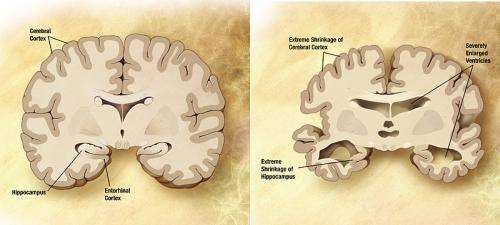Mining big data yields Alzheimer's discovery

Scientists at The University of Manchester have used a new way of working to identify a new gene linked to neurodegenerative diseases such as Alzheimer's. The discovery fills in another piece of the jigsaw when it comes to identifying people most at risk of developing the condition.
Researcher David Ashbrook and colleagues from the UK and USA used two of the world's largest collections of scientific data to compare the genes in mice and humans. Using brain scans from the ENIGMA Consortium and genetic information from The Mouse Brain Library, he was able to identify a novel gene, MGST3 that regulates the size of the hippocampus in both mouse and human, which is linked to a group of neurodegenerative diseases. The study has just been published in the journal BMC Genomics.
David, who works in Dr Reinmar Hager's lab at the Faculty of Life Sciences, says: "There is already the 'reserve hypothesis' that a person with a bigger hippocampus will have more of it to lose before the symptoms of Alzheimer's are spotted. By using ENIGMA to look at hippocampus size in humans and the corresponding genes and then matching those with genes in mice from the BXD system held in the Mouse Brain Library database we could identify this specific gene that influences neurological diseases."
He continues: "Ultimately this could provide another biomarker in the toolkit for identifying those at greatest risk of developing diseases such as Alzheimer's."
Dr Hager, senior author of the study, says: "What is critical about this research is that we have not only been able to identify this specific gene but also the networks it uses to influence a disease like Alzheimer's. We believe this information will be incredibly useful for future studies looking at treatments and preventative measures."
The ENIGMA Consortium is led by Paul Thompson based at the University of California, Los Angeles, and contains brain images and gene information from nearly 25,000 subjects. The Mouse Brain Library, established by Robert Williams based at the University of Tennessee Health Science Center, contains data on over 10,000 brains and numerical data from just over 20,000 mice.
David explains why combining the information held by both databases is so useful: "The key advantage of working this way is that it is much easier to identify a genetic variant in mice as they live in such controlled environments. By taking the information from mice and comparing it to human gene information we can identify the same variant much more quickly."
And David thinks this way of working will be used more often in the future: "We are living in a big data world thanks to the likes of the Human Genome Project and post-genome technologies. A lot of that information is now widely shared so by mining what we already know we can learn so much more, advancing our knowledge of diseases and ultimately improving detection and treatment."
More information: The paper is available online: www.biomedcentral.com/1471-2164/15/850


















